I Tried 6 Costco Steaks & Only One Cut Is Truly Amazing for Its Price
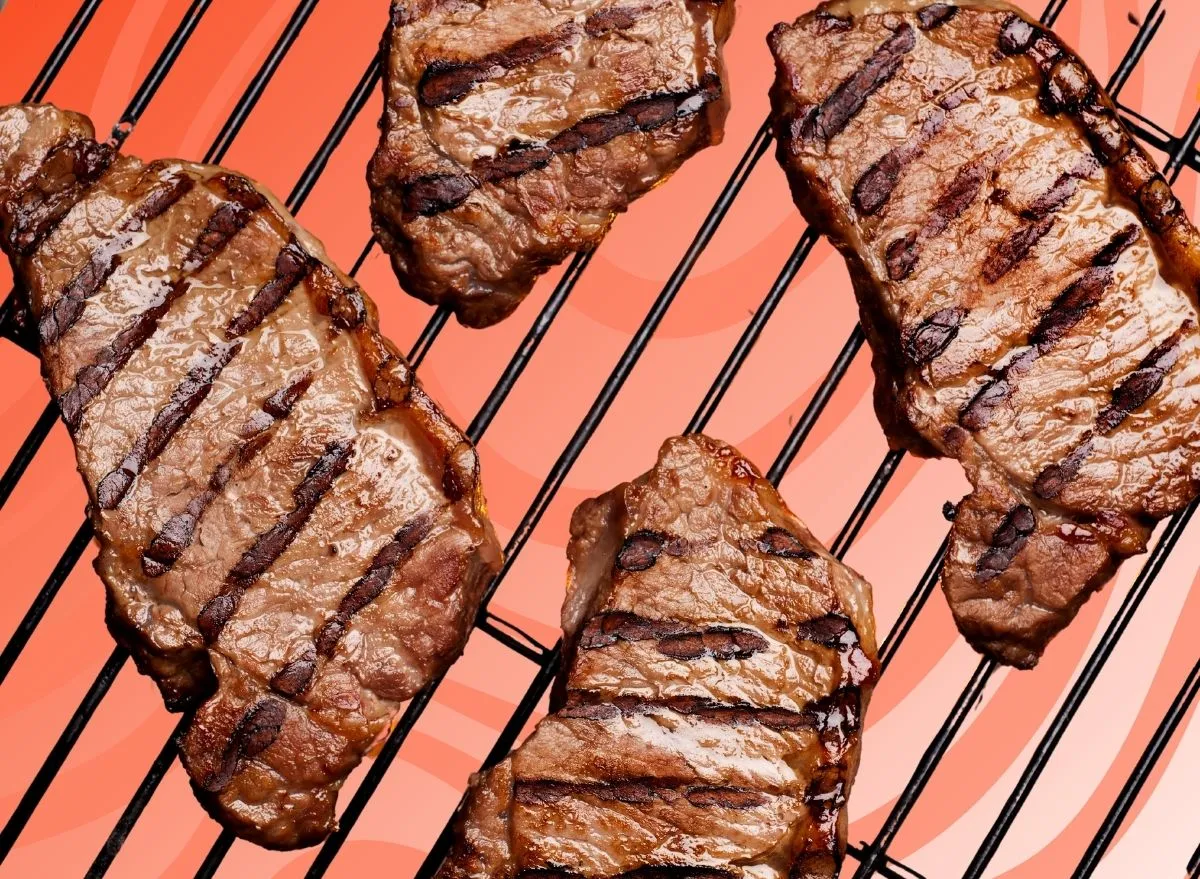
If you've ever shopped for steaks at Costco, then you probably faced this dilemma in the meat department: should you buy a pack of perfectly good-looking slabs of your favorite cut of beef at the standard rate? Or, pay a higher price—sometimes much higher—for a more premium version of the same steak?
Unlike some grocers, Costco doesn't really sell cheap, lean steaks. The popular warehouse club primarily stocks top-grade, fatty cuts (packaged in bulk, of course, because it's Costco). You basically get two options, each classified according to U.S. Department of Agriculture standards: USDA Choice or USDA Prime. Both are considered high-quality meats. The only real difference is the fat content. Well, that and the price.
Prime is the highest grade awarded by the USDA. Prime steaks come from young cows and feature the most prodigious marbling. By that, I mean the bands of white fat streaking through the reddish muscle. The more marbling, the more tender, juicy, and flavorful your steak tends to be. Prime steaks are primarily served at luxury hotels and high-end steakhouses like Ruth's Chris and Morton's. You don't often find them at the neighborhood supermarket, and the fact that Costco sells them is a big draw for the warehouse club.
Choice is the second highest grade, per USDA. Choice steaks are a bit less fatty but still very tender, juicy, and overall good-quality pieces of meat. They're also a bit more affordable than the top-of-the-line cuts—costing about 20% to 25% less in some cases. That's why you commonly find these steaks at more casual restaurant chains like Texas Roadhouse and Outback Steakhouse.
If you're not a professional chef, and you lack the expert skills and precision tools to recreate a restaurant-quality steak at home, then you're probably wondering why you would even consider shelling out the extra dough for some highfalutin Prime cuts. Would your palate even notice the difference? Because you know your wallet would!
That's why I conducted this little experiment. I rounded up packs of three popular steaks from Costco—ribeye, sirloin, and New York strip—including one of each USDA Choice and USDA Prime variety. That's a total of six different steaks. The mission: to see if there is any distinct difference to the average customer or whether paying the extra money is even remotely worth it. (Note: the prices listed below reflect the current in-warehouse rates at my local Costco in Brooklyn, N.Y. Online prices are generally higher.)
Here's how each cut compared to its other-grade counterpart.
New York Strip: Choice vs. Prime
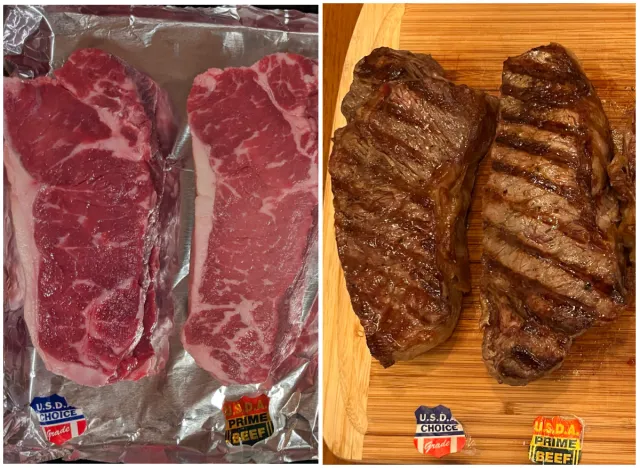
The classic strip steak is my go-to cut for home cooking, and Costco lately has become my main source for these. The cuts are always big and thick, and a four-pack usually nets me two meals for my family of four (plus bountiful scraps for the dog). Up until now, I've always stuck with USDA Choice because the total price is already considerable (at least $50 or more) ,and the steaks look good enough that paying more seems like an unnecessary indulgence. For this test, I got both. Priced at $11.99 per pound, a 5-pound pack of boneless USDA Choice beef loin strips will cost you nearly $60, while the higher-end USDA Prime strips, priced at $19.99 per pound, ring up closer to $100 for a similarly sized pack of steaks.
The Look: The Choice strips appeared super fresh. The meat came dark red, with substantial marbling throughout and a slender fat cap along the side. The Prime cuts, meanwhile, had a slightly paler tone but noticeably more marbling. Topographically, the shape of these fatty streaks sort of reminded me of the Finger Lakes in Upstate New York. From the respective 4-packs, I picked a 15.5-ounce Choice strip and a 1.2-pound Prime strip and grilled them both to medium rare. Once I dug in, I could see a distinct difference in the grain of each cut: the muscle fibers in the Prime steak ran in long, clearly defined lines, while the threads in the Choice cut looked all jumbled.
The Taste: The Choice strip tasted just as rich and juicy as usual, but I hadn't noticed how chewy it was until I tried the Prime version. The difference is striking. The higher-end cut immediately proved much more tender and luscious. All of my dining companions agreed that the Prime strip packed more flavor and richness than its Choice counterpart. My discerning wife asserted that the Prime cut "represents Costco well." The other strip? Not so much. She added, "I'm giving the Choice steak to the dog."
Ribeye: Choice vs. Prime
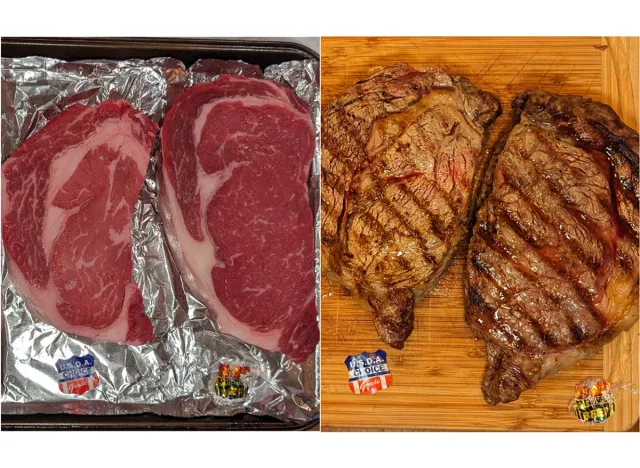
The ribeye is reputedly a very well-marbled steak in general, and though I don't usually cook this cut at home, it's often the move when I'm dining in a restaurant. The ribeyes at Costco are massive, generally coming three to a pack versus four with the strips. These cuts are currently priced at $14.99 per pound for USDA Choice and $21.99 for USDA Prime, meaning a comparable 4.5-pound pack will set you back over $67 for the Choice version and over $99 for Prime.
The Look: Both grades appeared quite similar in color, with considerable fat caps and thick internal ribbons of marbling in each. Upon closer inspection, the prime cut showed more tiny flecks of white throughout. I chose two hulking steaks from each pack to grill, both weighing well over a pound. They each charred up nicely, turning out beautifully pink and moist inside.
The Taste: Virtually identical. Both steaks came out terrifically tender and super succulent, making it difficult to distinguish one from the other in a side-by-side comparison, especially following the stark contrast between the two strips. Given these similarities, you should really question the need to spend more on the pricey Prime cut when the cheaper Choice steak is just as flavorful. Even the missus, who normally appreciates the finer things, endorsed a practical approach with this particular cut: "I would get the cheaper one because there is no noticeable difference."
Sirloin: Choice vs. Prime
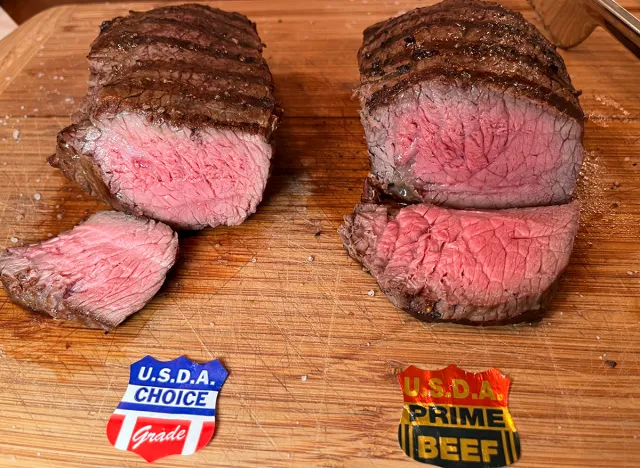
Sirloin steak is normally a lot leaner than other popular cuts like ribeye. Nevertheless, it can pack a surprising amount of flavor when it's done right. Compared to the other Costco steaks, the price difference between the two grades is much less significant with the sirloin: $9.99 per pound for USDA Choice and $11.99 per pound for USDA Prime. So, essentially, you'll pay around $40 for a 4-pound pack of Choice steaks versus $48 for a comparable pack of Prime cuts.
The Look: Lean and muscular. Neither the Choice nor the Prime sirloin showed much in the way of marbling. The higher-grade version featured a few more specks, but overall, these were mostly solid-colored masses of very red meat. What they lacked in fat, however, they surely made up in size. Both varieties came very thick and plump, requiring a little longer cooking time than the others so they didn't turn out too rare. Each achieved a lovely pink center, though the grain looked a little loose in the Choice cut, compared to the tight web of fibers in the Prime steak.
The Taste: Though both steaks came out perfectly juicy, there were some noticeable differences. The Choice sirloin offered more of a traditional beefy flavor but texturally felt more sinewy and chewy. The Prime sirloin, meanwhile, tasted more luscious with a much softer bite. Which is the better steak? That likely depends on which quality you hold most dear: taste or texture.
The Verdict
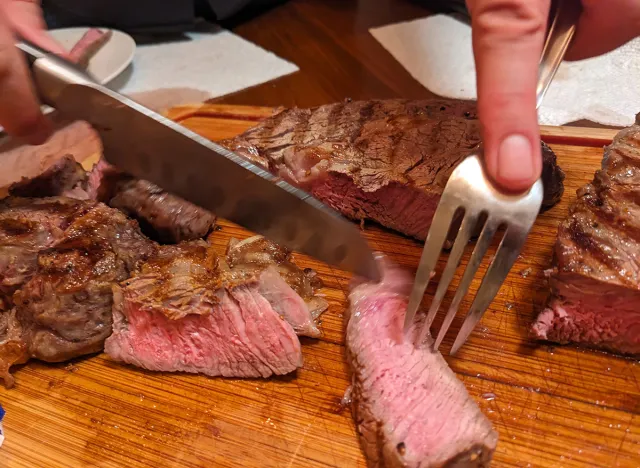
If you're looking to step up your cooking game with a higher-quality steak, then the Prime New York strip at Costco is a good move. It's far superior to the more economical, lower-grade version of the same steak in both taste and texture. Therefore, it's the only steak in this taste test that is even remotely worth the hefty markup for Prime-grade beef.
Costco's Prime ribeye is also quite good but virtually indistinguishable from its lower-cost equivalent, making that attempted upgrade look foolish by comparison. Paying $2 more per pound for a Prime sirloin, meanwhile, may net you a more tender piece of meat, but you might also lose some flavor in the process, and the price difference is negligible at best.
As a strip man myself, I previously had no idea what I was missing by purchasing the Choice steak instead. Now that I know the difference, there is no going back.
Steak night at my home is about to get even more delicious—and even more expensive, too.
Why Trust Eat This, Not That!?
Eat This, Not That! is committed to creating high-quality content that you can trust to be accurate, properly researched, routinely reviewed, and updated with the latest information. Our writers, editors, and medical and/or certified experts consider this to be an unwavering promise we make to our readers in the pursuit of delivering impactful and meaningful content.









